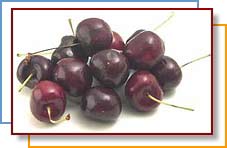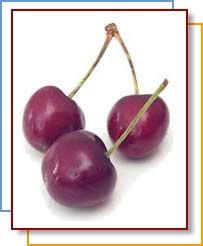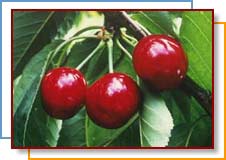
Cherries are drupes, or stone fruits, related to plums and more
distantly to peaches and nectarines. They have been enjoyed since the
Stone Age-pits were found in several Stone Age caves in Europe. The Romans
carried cherries throughout Europe and England along the routes of
conquest.
Cherries are grown in several regions of this country, but seventy percent
of the cherries produced in the United States come from four states (Washington,
Oregon, Idaho, and Utah).
| |
|
Cherries |
Serving
Size 1/2 cup (70g)
|
Amounts
Per Serving |
% Daily
Value |
| Calories
45 |
|
| Calories
from Fat 0 |
|
| Total Fat
0g |
0% |
| Saturated
Fat 0g |
0% |
| Cholesterol
0mg |
0% |
| Sodium 0mg |
0% |
| Total
Carbohydrate 11g |
4% |
|
Dietary Fiber 2g |
7% |
|
Sugars 10g |
|
| Protein 1g |
|
| Vitamin A |
2% |
| Vitamin C |
8% |
| Calcium |
2% |
| Iron |
2% |
* Percent Daily Values are based on a
2,000 calorie diet. |
|
| |
|
There are two main types of cherries: sweet and sour. Sour cherries are
lower in calories and higher in vitamin C and beta carotene than sweet
cherries.
Montgomery
This variety is the best known sour cherry. It is mostly canned or
frozen for use as pie filling or sauce. They are grown mostly in the eastern
and Midwestern states.
Bing
This variety is the best known sweet cherry. It is large, round,
extra-sweet and has a purple-red flesh and a deep red skin that is close to
black when fully ripe. The Bing is available from the end of May until early
August.
Lambert
This variety is the second most popular sweet cherry. It is smaller than
the Bing and is more heart shaped. It has a dark-red skin and a rich flavor.
Lamberts are available a bit longer than the Bing, usually until the end of
August.
Rainier
This variety is sweet with a yellow or pinkish skin. It is milder and
sweeter than the Bing. However, this variety is grown in limited quantities.
Royal Ann
This variety has a blush-yellow skin and is often canned or made into
maraschino cherries.
 Buy cherries that have been kept cool and moist, as flavor and texture
both suffer at warm temperatures. Cherries have a limited growing season
and any fresh cherries grown in the United States sold after August probably came
from cold storage. Small quantities of sweet cherries are imported from
New Zealand during the winter months, but these may be difficult to find. Buy cherries that have been kept cool and moist, as flavor and texture
both suffer at warm temperatures. Cherries have a limited growing season
and any fresh cherries grown in the United States sold after August probably came
from cold storage. Small quantities of sweet cherries are imported from
New Zealand during the winter months, but these may be difficult to find.
At the market, pick a handful of cherries at a time and only select the
best fruit. This may be time-consuming, but the reward will be better
cherries. Good cherries should be large (one inch or more in diameter),
glossy, plump, hard and dark-colored for their variety. Buy cherries with
stems on — they should be fresh and green. Reject undersized cherries or
those that are soft or flabby. Avoid fruit that is bruised or has cuts on
the dark surface.
If you find many damaged fruits at the market, consider buying cherries
somewhere else, as a number of spoiled cherries will start the others to
decay.
Loosely pack unwashed cherries in plastic bags or pour them into a
shallow pan in a single layer and cover with plastic wrap to minimize
bruising. Store cherries in the refrigerator and cherries in good
condition should last up to a week. Check the fruit occasionally and
remove the cherries that have gone bad. Wash the fruit before eating.
 You can freeze cherries by rinsing and draining thoroughly, spreading them
out in a single layer on a cookie sheet and placing in the freezer
overnight. Once the cherries are frozen, transfer them to a heavy plastic
bag. The frozen fruit may be kept up to a year.
You can freeze cherries by rinsing and draining thoroughly, spreading them
out in a single layer on a cookie sheet and placing in the freezer
overnight. Once the cherries are frozen, transfer them to a heavy plastic
bag. The frozen fruit may be kept up to a year.
Most cherries bought at the market are eaten raw, alone or accompanied
by other fruits. Simply wash the fruit and serve with the stems.
For cooking, pit cherries either by hand or with a pitter. Poaching is the
most common form of preparation. Drop cherries into a small amount of
simmering water, or a combination of water and wine, and cook for one to
three minutes until soft. Poach using the formula of one cup liquid to two
cups cherries.

Recipes
Fresh Northwest Cherry Salsa
Makes 4 servings
Each serving equals 1/2 cup of fruit or vegetables
Source: Produce for Better Health
Ingredients
2 cups pitted fresh or frozen sweet cherries
1/3 cup Basil, fresh, chopped
1/3 cup Green peppers, finely chopped
2 tsp Lemon juice
½ tsp each of: Worcestershire sauce and grated lemon peel
¼ tsp Salt
Dash of bottled hot pepper sauce
Chop cherries in food processor or manually. Combine all ingredients;
mix well. Refrigerate at least 1 hour.
Nutritional Analysis: Calories 124, Protein 0g, Fat 0 G, Of Calories
From Fat 2%, Cholesterol 0 Mg, Fiber 5 G, Sodium 168 Mg.

Find more in our
recipe database!
|



